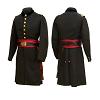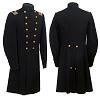Reference Items
Uniforms
|
|
Cavalry Enlistedman Musician's Jacket
|



Click on an image to enlarge
|
Regulation 1855-pattern cavalry musician’s shell jacket with yellow, worsted lace "herringbone form” braids across the chest. This pattern was continued and included in the 1861 Uniform Regulations.
This rare jacket is well preserved, with slight field wear; the coat is of Civil War manufacture and exhibits a 2½” high collar with two buttons on each side and standard cavalry "pillows” on the backside. The body lining is loose brown cotton weave, the sleeves in green and cream colored striped cotton, and the collar is lined with black cotton. The worsted wool trim is cavalry yellow and in fine condition.
Also featured are the original twelve buttons and rare, original brass shoulder scales. The scales are attached to the uniform by a tongue on the bottom of the scale, which slides through a brass keeper sewn onto the shoulder of the uniform. At the collar, a rotating stud device or "scale button,” turns and locks the shoulder scale into place. These shoulder scales were not particularly popular with the soldiers, as their required maintenance and inconvenience of wear outweighed any perceived benefits, and they had virtually disappeared from use by the midpoint of the Civil War.
Member - Mike Shotwell
Item #: CIV-188
|
|
|
Cavalry Frock Coat - Major Robert C. Wallace
|


Click on an image to enlarge
|
Major Robert C. Wallace of the 5th Michigan Cavalry wore this mid-war pattern, single breasted frock coat. It features a black velvet turn-down collar, and matching staff buttons which are original to the coat. The coat is entirely hand stitched, tailored in a dark indigo wool fabric. The lining is full length dark green/black polished cotton, with a padded breast containing two pockets. The 5” wide cuffs bear three functional staff buttons; the sleeves widen to 9" at the elbows and are lined with white cotton. Two tail pockets are lined in brown polished cotton and three of the four buttons are present on the tails. The GS-18 buttons all bear "Horstmann & Co. NY & PHI” markings (see Guinn & Bazelon fig. 6, #7.) Two cavalry major shoulder straps are sewn at their corners to the coat. A few tiny moth nips are present, but do not detract from its overall appearance.
A variety of additional items belonging to Major Wallace appear on this website, including buttons saved by him from his previous coats. Four published texts are found in the "Articles” section of this website on Wallace and his actions during the Civil War.
Wallace was appointed to the staff of Brigadier General A.T.A. Torbert in May, 1864 as Aide de Camp; (see staff photo in the "Finding Major Wallace" article.) Following Appomattox, Wallace rejoined the 5th Michigan Cavalry and was promoted to the rank of Major, while in the field, on 3 May 1865.
Member - John Beckendorf
Item #: CIV-184
|
|
|
Officer's Uniform Grouping - William D. Dixon
|






Click on an image to enlarge
|
William Dunlop Dixon enlisted with the 35th Pennsylvania Volunteer Infantry (also known as the 6th Pennsylvania Reserves) at its formation on April 24, 1861 at the age of 27. He received a commission as Captain of Company D, was promoted to the rank of Lieutenant Colonel on September 12, 1863. The 35th fought with the Army of the Potomac for its entire period of service, seeing action at Antietam, Fredericksburg, Gettysburg, The Wilderness and Spotsylvania Court House. Colonel Dixon survived the war and mustered out of the service on June 11, 1864 after the regiment’s term of enlistment expired.
The diverse grouping includes Dixon’s double breasted frock coat which bears his triple border Colonel’s rank insignia and a complete set of original infantry staff buttons. His mounted officer’s trousers have an infantry blue welt down the 33” outside seam (written on the inside face of his watch pocket is "Capt. W. Dixon with size notation 33¼”). Also present are his silk crimson sash, his officer’s grade belt and holster rig with his Colt Army revolver, serial #61756 indicating mid-1862 manufacture. Additional personal effects include a Gettysburg reunion medal, a variety of separate shoulder straps, and Dixon’s line-officer grade dress epaulets.
Member - John Beckendorf
Item #: CIV-173
|
|


Click on an image to enlarge
|
Regulations for these winter overcoats were established in 1851 and remained unchanged for 20 years. The long coat and matching cape were sewn from coarse Kersey wool, dyed light blue. For collectors, color and weave on the cape should match the fabric on the coat itself.
Made by arsenals and private contractors alike, most are size stamped in the sleeve with maker’s and or inspector’s stamps. The coat body is lined with the standard brown course weave flannel. The sleeves are lined with standard white linen, and include lengthy fold-down cuffs for fowl weather use. The buttons on the cape and coat are federal general service (eagle with shield). Belt rigs, cartridge boxes and other accouterments were worn beneath the cape, but over the coat.
The standard 1851 pattern dismounted overcoat is distinguished from the mounted overcoat by its five single breasted buttons and stand-up collar, which is similar to the shell jackets. Its cape ends at about the elbow of the sleeve and carries six buttons, the rear slit is 13¾” in length.
These coats saw hard winter use but were often discarded at the first sign of fair weather, their size and weight being too bulky for summer campaigning.
Member - Mike Sorenson
Item #: CIV-160
|
|
|
Uniform Grouping - Sgt. Hugh Burns, 40th New York
|





Click on an image to enlarge
|
This grouping includes a privately made 4-button sack coat, tailored with officer’s grade broadcloth. It belonged to Sgt. Hugh W. Burns of the 40th New York Infantry, or the "Mozart Regiment." The jacket features a black velvet fold-down collar, four standard federal infantry buttons and is lined with an officer’s grade green polished cotton. The 22½” sleeves are widely tapered at the elbow and bear their original 1st sergeant’s chevrons. The standard white cotton lining is marked inside the left sleeve in period ink: "H. W. Burns.” Accompanying the jacket is Burns’s forage cap made of the same fine quality broadcloth, adorned by a cloth First Division, 3rd Corps badge, which is embroidered with the Mozart regiment’s "40”. The cap's original cotton liner, Federal eagle I buttons and leather sweatband are intact. The grouping also includes Burns’s Mozart Regiment reunion pin (absent its original ribbon) and the regimental history, History of the Mozart Regiment published by Stanhope Press in 1909.
Hugh Burns left his work as an engraver and enlisted originally with the 55th New York Infantry, also known as the Garde Lafayette, on October 23, 1861. As a corporal in the Army of the Potomac, Burns saw action at the following engagements; Battle of Williamsburg; Seven Pines; Malvern Hill; and the Battle of Fredericksburg. On December 21, 1861, the depleted 55th New York was merged with the 38th New York Infantry. The refurbished 38th went into action at Chancellorsville a few weeks later.
On June 3, 1863 the 38th was merged into yet another unit, the 40th New York Infantry, known alternatively as the Mozart regiment and the Constitution Guard. A month later, Burns was wounded in desperate fighting at the Slaughter Pen in Gettysburg. In November, 1863, he returned to the regiment, his recovery now complete. He reenlisted for the duration of the war and was promoted to the rank of sergeant. As the conflict continued, Sergeant Burns took part in the actions at Kelly’s Ford, Payne’s Farm; The Wilderness; Spotsylvania; the Bloody Angle; and Cold Harbor. During fighting at the Wilderness, Burns was wounded for a second time as a bullet creased his chin.
Surviving the Civil War, Sergeant Burns returned to New York where he married and raised four children. He returned to his work as an engraver and is credited with the illustration of the Mozart Regiment’s charge into the Slaughter Pen at Gettysburg that appears in the 40th’s regimental history.
Member - Mike Sorenson
Item #: CIV-158
|
|
|
Enlistedman's Nine-button coat - Infantry
|

Click on an image to enlarge
|
This enlistedman’s 9-button frock coat is an example of one of the more sought after coats of the Civil War period.
The enlistedman's coat is a single-breasted frock of dark blue cloth, with a skirt that extends approximately to the thigh of the wearer; one row of nine buttons is present on the breast, equally spaced. Regulations did not specify the height of the stand-up collar, only that it was to rise no higher than what would allow the chin to turn freely over it. The collar is equipped with a metal clasp at the front, and at its center, the opening between them to be 60°. The cuffs are fitted with two small buttons. The cuff and collar and are edged with a welt of cloth, colored for the branch of service, in this case, sky blue for infantry. Two pockets exist in the folds of the skirts with one matching button at each hip
All 15 buttons have 100% original gilt finish with matching early Waterbury Button Co. rmdc backmarks. All are on original thread, but two of the breast buttons have been strengthened. Light blue cord piping is perfect and tight as are all seams on the coat. Blue wool broadcloth still has its original knap feel on the surface. The body lining, sleeve linings and skirt pockets are all original and excellent.
Member - Mike Sorenson
Item #: CIV-123
|
|